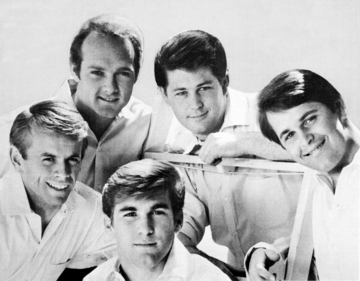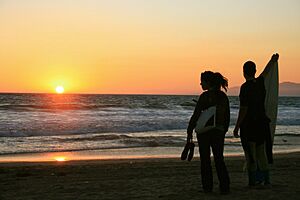California sound facts for kids
The California sound is a type of popular music that started in Southern California in the early 1960s. It was first linked to the idea of the "California myth." This myth was about an ideal, sunny lifestyle inspired by the state's beach culture. You could often hear this theme in the lyrics of popular songs.
Later, the California sound grew beyond just beaches and cars. It became more complex and often used new studio tricks. It was known for its hopeful, sunny feeling, like the life of a teenager in Southern California in the 1960s.

The Beach Boys, especially Brian Wilson, helped start this sound with their first song, "Surfin'", in 1961. Along with Jan and Dean, the Beach Boys sang about surfing, cool cars (hot rods), and the fun of being young. They turned a local California lifestyle into a famous American story.
While other artists like Dick Dale made surf music before, the Beach Boys added a whole new way of looking at the world. Other important people who helped create the sound included songwriters and producers like Gary Usher, Curt Boettcher, Bruce Johnston, Terry Melcher, and Roger Christian.
Over time, the California sound changed. It became more about serious topics and less about surfing and cars. It started to include ideas about social issues and being aware of what was happening in the world. Between 1964 and 1969, it encouraged new ideas in music. It inspired artists to sing about topics like pride in one's background, political ideas, and other themes from the 1960s counterculture. A style called sunshine pop grew out of the California sound.
Contents
How the California Sound Started
The California sound is often said to have begun with the Beach Boys' first song, "Surfin'", in 1961. Brian Wilson, the band's leader, also worked with Jan Berry. Together, they wrote and produced many hit songs for other artists. These songs later became known as part of the California sound.
University of Southern California history professor Kevin Starr said the Beach Boys were important because they showed what the "Silent Generation" was like. He described this generation as not very interested in politics. He explained that the group "could not help but mythologize a landscape and way of life that was already so surreal." This means they made the California lifestyle seem like a legend. Cars, the beach, surfing, and the "California Girl" all came together in their music. This created a new sound and a way of life that felt almost magical. The California sound was like turning the California myth into music.
Harry Sumrall, in his book Pioneers of Rock and Roll, explained it well:
[The Beach Boys] virtually defined the image of surfers, hot rods, sun, beaches, girls, and fun, fun, fun that became the California myth. The titles of their songs said it as well as anything: "Surfin' U.S.A.," "Little Deuce Coupe," "Surfer Girl," "Fun, Fun, Fun," "Dance, Dance, Dance," and "California Girls". With these hits and others, the group's bassist and songwriter, Brian Wilson, created a new sound in rock and roll. It was called the "surf sound", but in fact it was a combination of older rock verities set in entirely new lyrical and musical contexts.
The Beach Boys' surf music wasn't completely new. Artists like Dick Dale made surf music before them. But earlier surf musicians didn't share a whole way of life like the Beach Boys did. Brian Wilson once said about the California myth: "It's not just the surfing; it's the outdoors and cars and sunshine; it's the society of California; it's the way of California."
Al Jardine from the Beach Boys said, "It's not entirely a myth. There are still some elements that are certainly true." He added that driving along the coast on Route 1, seeing the ocean and sea life, "It's really magical. It really is." Capitol Records producer Nick Venet, who worked with the band early on, thought their song ideas came mostly from Hollywood movies.
AllMusic's review of the Beach Boys' song "All Summer Long" calls it a great example of the California myth. It shows an "idyllic dream world of sun, surf, and fun." Author Luis Sanchez believes the whole album All Summer Long (1964) was the closest the Beach Boys got to a perfect version of the California myth. The song "Don't Worry Baby" hinted at a change in the California sound. While "I Get Around" was all about carefree sunshine, "Don't Worry Baby" suggested something deeper and a bit darker.
Spreading the California Sound
The Beach Boys kept making their version of the California myth bigger. It grew so much that it went beyond just pop music. It broke through limits of music styles, what people expected to sell, and even where it came from. Brian Wilson's work with Gary Usher helped a lot with this.
This duo helped create a big new market for the California sound. This allowed musicians Bruce Johnston and Terry Melcher to focus on the Rip Chords. This group then had hits like "Hey Little Cobra" (about hot rods) and "Summer Means Fun" (a surf-like song).
Historian Matthew Allan Ides wrote:
The writing duo of [Gary] Usher and [Roger] Christian, like that of Terry Melcher and Bruce Johnston, provided most of the lyrics, production and promotion to the vocal pop music that like instrumental surf music became associated with Southern California youth culture. Ironically, both Usher and Christian had come to California from the East Coast in the late 1950s, and neither had much experience with surfing or local youth. Nonetheless, Usher and Christian translated their impressions of teen life in Southern California into lyrics. Usher’s songs included "In My Room" and "The Lonely Surfer" and Christian’s hits numbered "Surf City", "Little Old Lady from Pasadena" and "Don’t Worry Baby".
Historian Kirse Granat May describes how surfing culture and the California sound spread:
By 1965, with the help of the California sound, the national diffusion of the surfing subculture was complete. It became a mainstream advertising image, keyed into California's youthfulness as "an element of the marketing picture." Pepsi used images of surfers and this pun, "Board Members of the Pepsi Generation". ... Surfing appeared on television sitcoms like Gidget and even entered the plots of shows like Dr. Kildare. ... In the wake of the surfing craze and the emergence of the California sound, American International Pictures (AIP) produced beach and surfing movies for appreciative teenage audiences, reinforcing marketable images. ... the Beach Party films exploited on the big screen what the Beach Boys set to music.
Luis Sanchez noted the difference between the Beach Boys' album Surfin' U.S.A. (1963) and other California-themed works. He wrote that the Beach Boys' music had a "genuineness" that made them stand out. This quality became important as Brian Wilson made bigger pop productions, leading to Smile.
Changes and Later Years
Brian Wilson's artistic ideas for pop music helped change the California sound. It became more musically complex and mature. Terry Melcher later worked with the Byrds, producing their 1965 folk rock song "Mr. Tambourine Man". This song's recording style was inspired by Wilson's work on "Don't Worry Baby."
Melcher's successful way of producing with the Byrds was quickly copied by many Los Angeles artists. These included the Turtles, the Leaves, Sonny & Cher, and Barry McGuire. The lyrics of California sound songs slowly moved away from surfing and cars. They started to focus more on social awareness and political topics.
By the 1970s, the "spirit" of the California sound continued with singer-songwriters like Lowell George, Jackson Browne, Tom Waits, and Rickie Lee Jones. They kept the sound fresh without using its old "clichés." The magazine Paste said that bands like Best Coast, Dum Dum Girls, and Wavves helped bring back surf rock and the California sound in the 2010s.
Types of California Sound Music
Surf Music
The California sound is sometimes used to mean the same thing as surf music.
Folk Rock
California folk rock artists included the Byrds, Barry McGuire, and the Mamas & the Papas.
Sunshine Pop
In 1966, Curt Boettcher helped create a style called sunshine pop. This was a spin-off of the California sound.
Other California Sounds
Some areas in California have their own special "sounds." These include the San Francisco sound (from San Francisco in the 1960s) and the Bakersfield sound (from Bakersfield in the 1950s). Historian Matthew Allan Ides noted that the popular Los Angeles sound often overlooked the music made by working-class people, non-white artists, and women.
In a Flavorwire article, they asked, "What is the quintessential California sound?" They listed 30 albums they thought were "the most Californian ever made." They explained that "the sound itself is important, but it's the lifestyles behind these scenes that come to define the music." Some of the artists mentioned were: Crosby, Stills, Nash & Young, Dead Kennedys, Fleetwood Mac, Green Day, Guns N' Roses, Jefferson Airplane, Joni Mitchell, Kendrick Lamar, N.W.A, No Doubt, Red Hot Chili Peppers, Snoop Dogg, the Beach Boys, the Doors, the Grateful Dead, and Tupac Shakur.


